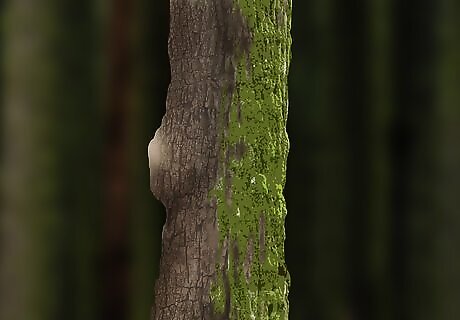
views
Using Constellations to Find the North Star

Use the pointer stars of the Big Dipper. You can easily locate the North Star by using the Big Dipper. The Big Dipper contains stars known as "pointer stars," which can be used to locate the North Star. To start, locate the Big Dipper. The Big Dipper is a constellation made up of seven stars. The constellation is found in the northern sky. In the spring and summer months, the Big Dipper will be somewhat high in the sky. In the autumn and winter months, it'll be lower in the sky. The Big Dipper is given its name because it's shaped somewhat like a bowl with a handle. Four stars form a trapezoid-like shape, the bowl portion. Stemming off of these four stars are three more stars, forming the shape of a slightly bent handle. Once you've located the Big Dipper, you can use it to find the North Star. To do so, look at the two bright stars that form the side of the bowl farthest away from the handle's tip. These are the "pointer stars." Draw an imaginary line connecting the pointer stars. Extend that line five times the distance between the pointer stars. You should eventually reach a somewhat bright star. This is the North Star. Note that you do not actually have to see the North Star with this method. If clouds or trees or mountains are in the way, the North Star is still there near the end of the fifth pointer length. That point is less than three degrees from the North Star and the North Celestial Pole.

Locate the tip of the Little Dipper's handle. The Little Dipper is the constellation that contains the North Star. The tip of the Little Dipper's handle is the north star. If you're able to locate the Little Dipper, you can easily spot the north star. You can use the Big Dipper to find the Little Dipper. Once you find the Big Dipper, look away from it as if water was coming out of the "open" part of the dipper. The Little Dipper will appear as a mirror image of the Big Dipper. It is also a constellation made up of seven stars. Four stars form a trapezoid base, and three extend out from this base to form a handle. The last star extending outward is the North Star. If you live in an urban area, it can be difficult to locate the Little Dipper. It is also difficult to discern on bright moonlit or hazy nights. You may be better off trying another method.

Rely on the arrow in the Cassiopeia constellation. Using the Big or Little Dipper are the most common means to locate the North Star. However, if the Big Dipper is low in the sky it can be difficult. Fortunately, you can use the constellation Cassiopeia to locate the North Star. Cassiopeia is a constellation that consists of five stars. They form an "M" or "W" shape. Cassiopeia is located in the north sky. In earlier hours, the constellation looks more like an "M." Between midnight and dawn, the constellation looks more like a "W." In the months of February and March, Cassiopeia is especially likely to appear as a "W." The three stars that form the middle portion of the "M" or "W" can be used to roughly locate the North Star. Look at this point as if it were an arrow. Follow the direction of the arrow forward. You should eventually land on a somewhat bright star. This is the North Star. Note that you will have to actually see the North Star for this method to work.
Finding the North Star with Technology

Locate the North Star with your smart phone. There are many smart phone applications that work something like a telescope. You enter your location, or allow the phone to find your location, and then point your phone to the sky. The phone acts as interactive map, identifying stars and constellations for you. Some applications can also enhance visuals, allowing you to see stars more easily. Sky Guide is an application for iPhones. The app can track your location and time. Then, you can hold your phone up to the sky and it will provide you a map. It can identify different constellations and stars. For an Android, there is an app known as Stellarium Mobile. It works the same as SkyGuide, but with a slightly higher resolution. You can better see stars and constellations through your phone when using Stellarium.

Invest in a star atlas. Star atlases have been around for a long time. If the idea of carrying your phone around while stargazing kills the fun for you, consider buying a star atlas instead. You should also always take an atlas with you when hiking in the event your phone battery dies. A star atlas is a book that breaks down the night sky by the region and time of year. You can use the graphics and charts provided in a star atlas to locate the North Star on any given night. Every star atlas is slightly different. There's usually a guide in back that provides information on how constellations are labeled. For example, small stars may be labeled by dots. Major stars, like the North Star, may be marked by large, red dots. A star atlas will provide a map, much like a map of a town or city, guiding you across the night sky on any given night. Select the map for your specific region and time of year and use that map as a guide. Bring a flashlight with you as you go out to stargaze so you can consult the map as needed. Practice using the star atlas before you go camping. It can take a while to get proficient at using a star atlas. Make sure you get lots of practice so, if you need to find the North Star in a pinch, you're well-prepared to use your atlas. Of course, where a star atlas really proves its worth is if it makes you familiar enough with the night sky that you don't need the atlas. Learn the characteristics and locations of The Big Dipper, Cassiopeia, Orion, Leo, Pegasus, and Crux. Be able to find directions when the need arises unexpectedly and you're without your compass, or GPS, or atlas.

Plan ahead with your computer. You can use desktop applications for your computer to know how the sky will look on a given night. These devices can help you plan ahead. You'll go outside with a rough idea of where you can expect to find the North Star. In addition to phone applications, Stellarium also provides a desktop application you can download on your computer to locate the North Star. It's available for Linux, Mac, and Windows. Your background would be the night sky, adjusted for your region and time of year. It will show you what you can expect the night sky to resemble on a given night, locating the North Star for you. You'll know where in the sky to look when you go out. If you have a Mac, PhotoPills is a photography planning application. You can use this if you're planning on photographing the night sky. Based on your location and the time of year, PhotoPills will simulate the galactic arch for you. This will form a map you can use later to locate the North Star.
Finding the Direction North

Figure out which direction is north using two sticks. If you don't know what direction you're facing, finding constellations can be a struggle. This can inhibit your ability to locate the North Star. Determining which direction is north can allow you to locate the North Star more easily. You can use two sticks to do so. First, find two sticks. One stick should be slightly bigger than the other. Place the sticks in the ground vertically. Place the taller stick slightly ahead of the shorter one. Lie down in front of the sticks. Line up one eye, forming a straight line between your eye and the two sticks. Wait for a star to appear in your line of vision. Stare at the star for a few minutes and wait for it to move. It if it moves up, you're facing east. If it moves down, you're facing west. If it moves right, you're facing south. It if moves left, you're facing north.

Create a shadow with sticks. If it's daytime, you may still be able to see the North Star. However, you'll be unable to rely on constellations as they're very difficult to see during the day. Instead, you can create a shadow with sticks and use that to locate north. Place a stick in the ground. Take a stone or other object and place it where the end of the stick's shadow falls. Wait about an hour. The shadow will move, either growing shorter or longer. Place another stick at the end of the new shadow. Then, stand at a perpendicular angle to the shadow. You are now facing north.

Pay attention to how moss is growing. If you're in an area where moss grows, you can use moss to help you locate north. Look for moss on vertical structures, such as trees. Moss requires a damp atmosphere to grow. This means moss usually grows on the north side of vertical structures, as the north side gets less sun.




















Comments
0 comment